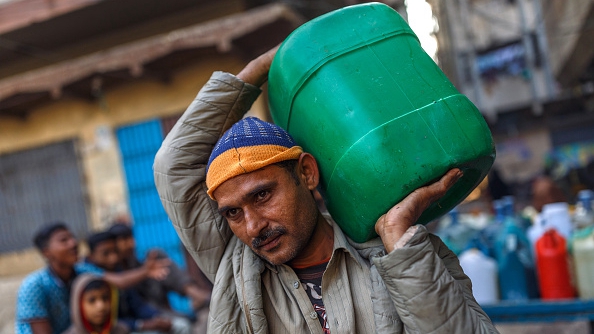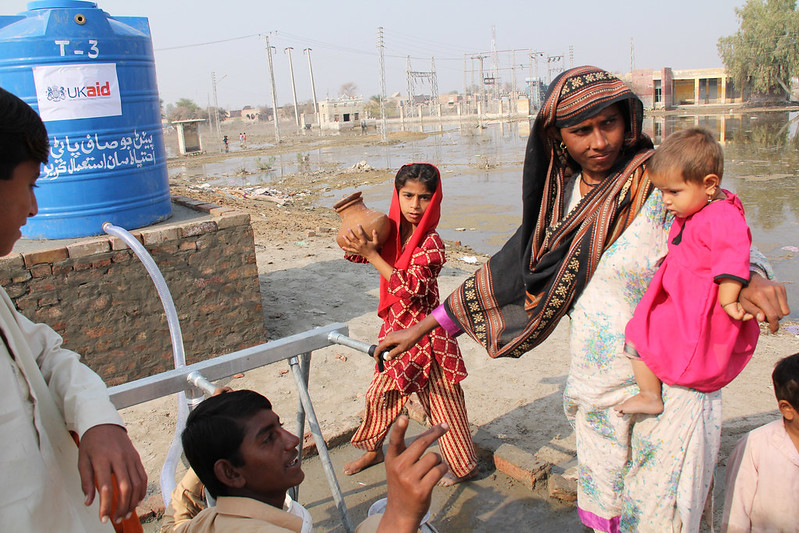
A man carries a container with water in Karachi, Pakistan, December 23, 2018. /Getty
A man carries a container with water in Karachi, Pakistan, December 23, 2018. /Getty
Editor's note: Alexander Ayertey Odonkor is an economic consultant, chartered financial analyst and a chartered economist with an in-depth understanding of the economic landscape of countries in Asia and Africa. The article reflects the author's opinions, and not necessarily the views of CGTN.
Pakistan, the world's fifth-most populous country, could experience acute water scarcity by 2025 and become the most water-stressed country in South Asia by 2040.
According to the United Nations Development Programme (UNDP), per capita water availability in Pakistan, has dropped from 2,172 cubic meters per inhabitant in 1990 to 1,306 cubic meters per inhabitant in 2015 – about 27.2 million people in the country do not have access to clean water. This inauspicious situation has led to a deplorable health situation whereby close to 39,000 children under the age of five die every year from diarrhoea caused by polluted water.
Although Pakistan extracts large quantities of fresh water from the ground per year, the country's water storage capacity has declined from the minimum requirement of 120 days to less than 30 days – this is partly attributed to a lack of appropriate infrastructure to store water for a long period.
The Mangla and Tarbela dams, which were commissioned in the 1960s and the 1970s respectively, have been the two major water storage facilities. Policymakers, development partners and other relevant stakeholders have done little to provide adequate water storage facilities that have the capacity to make clean water accessible to the growing population.
A recent World Bank report suggests that poor water management costs Pakistan 12 billion U.S. dollars per year, representing four percent of the country's GDP, even though the exiguous domestic water supply and poor sanitation are the major challenges associated with the management of water in Pakistan.
Irrigation dominates the use of water in Pakistan – economically, irrigation in Punjab contributes 22 billion U.S. dollars to GDP, but the four major crops: cotton, wheat, rice and sugarcane use more than 80 percent of water from irrigation facilities on farmland accounting for only five percent of the country's GDP. This clearly indicates that in the growing of the four major crops, water from irrigation facilities should be managed effectively to avoid the perennial misuse of water on farmland.
The agriculture sector is an integral component of Pakistan's economy, employing 43 percent of Pakistan's workforce, yet water productivity has generally been low in recent years. This has impeded the growth of the sector. Apart from using water for irrigation purposes, Pakistan relies on water to generate power – currently hydropower represents close to 30 percent of the total power capacity – this is the smallest share for hydropower in the country's history.
To exploit the untapped potential of hydropower and also improve the quality of life in the country, it is imperative for policymakers and development organizations to ameliorate water management practices. Water-related diseases are the leading cause of suffering and deaths in Pakistan, as approximately 60 million people in the country are exposed to high concentrations of arsenic in drinking water. Arsenic poisoning could cause diabetes mellitus, cancer, cardiovascular diseases, neurological impairments and problems in endocrine glands as well as socio-economic challenges.

People displaced by the 2010 flooding in Pakistan collect clean drinking water from a tapstand in the town of Ghari Kharo, western Sindh province. /Alexander Ayertey Odonkor
People displaced by the 2010 flooding in Pakistan collect clean drinking water from a tapstand in the town of Ghari Kharo, western Sindh province. /Alexander Ayertey Odonkor
To mitigate the current health hazards associated with polluted water, it is essential for policymakers to focus on creating policies that will make clean water accessible to both the rural and urban population – to bring this ideal plan into fruition, Pakistan needs to develop and implement viable evidence-based water management policies. Effective water management policies will conserve water resources, decrease the pollution of drinking water and improve the quality of sewage facilities and water supply.
Such policies should include an implementation framework with emphasis on the role of water data and information; strengthen provincial capacity for monitoring and reporting the distribution and usage of water. These policies should augment the capacity of institutions concerned with river basin management by providing financial support and other necessary resources to organizations such as the Pakistan Water and Power Development Authority and the Indus River System Authority.
Again, reforestation programmes should be implemented to curb the dwindling of Pakistan's forest cover – as the country's population continues to grow, the forest area per capita has also been declining. This is partly because about 68 percent of the total population rely on firewood as the main source of energy in households. The continuous usage of large quantities of trees from forests as firewood and other purposes could have dire consequences for a country such as Pakistan, that has a low forest cover of 0.03 hectares of forest per capita. Pakistan's proportion of forest cover is extremely small when compared to the world's average of 1 hectare.
Currently in Pakistan, 42,000 hectares of forest cover is lost every year, representing 2.1 percent of the entire forests – at this rate of deforestation, the country's forests could be lost in the next 50 years if germane measures are not implemented to increase reforestation.
By carrying out adequate and extensive reforestation projects in Pakistan, depleted forest cover could be restored. This will lead to an increase in rainfall patterns, stabilization of climate and temperature levels and reduction in air and water pollution.
Reforestation can also minimize the recurring floods which have been one of the major challenges of water management in Pakistan. The building of dams should be prioritized, focusing distinctively on consultative processes for effectual broad stakeholder input – this will reduce the social and environmental cost thereby making the construction of these dams socially-responsible real estate developments.
Compared to large dams, this consideration makes small dams the best choice as they pose minimal social and environmental costs – water from the small dams can be appropriate for domestic use, irrigation, generation of electricity and fish farming.
To enhance the sustainability of this project, hundreds of these small dams should be built at appropriate locations such as the Khyber Pakhtunkhwa province, which is rich in aquatic and terrestrial biodiversity – infrastructure developments of this magnitude have the capacity to decrease the frequent occurrence of floods, which have plagued the management of water resources in Pakistan for many years.
If the leadership of Pakistan is able to implement and monitor the progress of all these directives effectively, then water security will definitely be improved and many lives will be saved in the country.
(If you want to contribute and have specific expertise, please contact us at opinions@cgtn.com.)